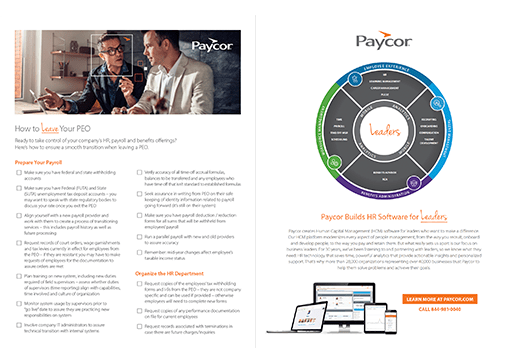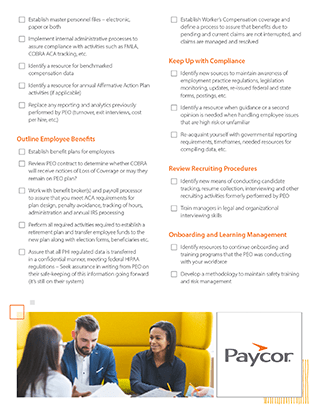Your Step-by-Step Guide to Leaving a PEO
Use this checklist as a guide for a smooth transition away from HR and payroll PEO services.
Many smaller companies work with Professional Employer Organizations (PEOs) for HR, payroll, and benefits services. This arrangement is known as co-employment, in which the PEO becomes the employer of record for tax purposes and the company’s employees technically work for the PEO. This model can appeal to businesses at first because it feels like they’re sharing the responsibility.
We know the thought of switching from a PEO to a payroll provider can be intimidating, but Paycor has the expertise and technology to ensure a smooth transition. Download and share this checklist with your clients as a resource to help them make an informed decision.
FAQ
What is a PEO?
A PEO is a private company that partners with other businesses, often small businesses. PEOs help companies manage administrative tasks like HR, payroll, and compliance. Legally, the business’s workforce is employed by the PEO.
What are the benefits of a PEO?
PEOs can reduce HR’s administrative burden and lower costs – in the short term. These organizations typically offer low-cost benefits, which can seem very attractive.
What are the cons of a PEO?
PEOs are for-profit companies. They’re motivated to work with a large number of businesses, legally employing a large number of workers. Because of the constant pressure to add new clients, the actual cost of benefits and the quality of their services can fluctuate.
Why would a business leave a PEO?
Like any other business partnership, your relationship with your PEO can change over time. If your costs are going up but the quality of service isn’t, it could be a sign that the PEO is struggling. And even if the PEO is keeping up its end of the agreement, your business could outgrow the arrangement. Larger and more successful companies need more control over their HR functions than a PEO can offer them.











